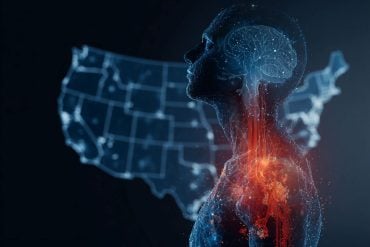Summary: New research suggests that prenatal exposure to SSRIs may alter brain development in ways that increase the risk of depression and anxiety later in life. Using mice and human data, scientists found that early-life SSRI exposure heightened activity in brain fear circuits, a pattern not observed in offspring of depressed mothers who did not take SSRIs.
These brain changes, which persist into adolescence, point to a serotonin-specific mechanism with lasting effects. While the findings raise concerns, experts caution that more research is needed before changing clinical guidelines for SSRI use in pregnancy.
Key Facts:
- Unique Brain Changes: SSRI exposure in utero increases fear circuit activity in both mice and children.
- Serotonin-Specific Effect: Children exposed to maternal depression without SSRIs did not show the same brain alterations.
- Caution for Pregnancy: While findings are significant, researchers stress it’s too early to recommend discontinuing SSRIs during pregnancy.
Source: Columbia University
Nearly two decades ago, Columbia researchers who were using mouse models to better understand the role of serotonin in depression got results that left them baffled.
The researchers genetically deleted the animal’s serotonin reuptake protein—the same protein inhibited by Prozac and other SSRI antidepressants—and expected to see mice behave as if they were taking the drug.
Credit: Neuroscience News
“By deleting the gene, we did genetically what Prozac does through pharmacology, increase serotonin signaling in the brain. But when these mice grew up, they seemed like they were on “anti-Prozac,” says Jay Gingrich, professor of developmental psychology (in the Department of Psychiatry) at Columbia University Vagelos College of Physicians and Surgeons, who led the study.
“They were more depressed, more stress-sensitive, and showed more signs of anxiety. We didn’t know how to explain it.”
Soon the researchers learned that the timing of increased serotonin signaling was key. In a follow-up study conducted with Mark Ansorge, associate professor of clinical neurobiology (in psychiatry), the researchers found that just a brief exposure to Prozac in a mouses’ first weeks of life—approximately equivalent to the third trimester in people—was enough to produce anxious, depressed behaviors later in the mouse’s life.
Consistent with the team’s mouse experiments, their subsequent studies comparing children exposed to SSRIs in utero to unexposed children showed an increased rate of depression in children whose mothers took SSRIs during pregnancy.
“These kids look pretty normal throughout early childhood, and then when they hit adolescence, their rates of depression really started to go up, which is exactly what we see in our mouse studies.” Gingrich says.
But separating the effects of in utero SSRI exposure from the effects of the mother’s depression is nearly impossible in human studies.
“The severity of the mother’s underlying depression could be causing the child to have a higher probability of being diagnosed,” Ansorge says.
To try to disentangle the use of SSRIs from the mother’s depression, Gingrich and Ansorge’s latest research has looked at the effect in utero SSRI exposure on the brain’s fear circuits in mice and children.
Fear circuits are often more active in depression and anxiety disorders. Gingrich and Ansorge hypothesized that they would be able to detect specific activity signatures that are unique to SSRI-exposed brains.
“With this approach, we’re really able to get at unique consequences of the SSRI exposure dissociated from the mother’s own depression,” Ansorge says.
The Columbia researchers say their findings—which show that brain circuitry is altered in the same way in mice and children exposed to SSRIs in utero—has put the idea that in utero exposure to SSRIs can have long-term effects on firmer ground.
We spoke with Ansorge and Gingrich about their findings and what they might mean for patients.
What is your study finding and why do you think that supports the idea that in utero SSRI exposure raises the risk of depression and anxiety later in adolescence?
Ansorge: Using the mice, we wanted better insight into what changes happen in the brain that link in utero SSRI exposure to altered behavior. And then we wanted to see if those changes also happen in people.

To this end, we exposed mice to predator odors while we recorded activity in their brain’s fear circuitry using an animal MRI machine. We saw that mice exposed to an SSRI early in development showed huge increases in the activity of their fear circuits compared to unexposed mice.
We then looked at children’s fear circuity responses when they were shown scary faces, which was MRI data collected as part of the Adolescent Brain Cognitive Development multicenter study. We saw the same exacerbated response in SSRI-exposed children that we saw in mice, but not in children whose mothers had depression but did not take SSRIs.
This kind of categorical finding, this on or off response, indicates to us that there is something very unique going on in the SSRI-exposed kids; they look completely different. It really speaks to a serotonin specific mechanism.
What’s been the reaction to your work?
Ansorge: The effects of in utero SSRI exposure on adolescents are not well understood. Basic scientists appreciate the role of serotonin in neurodevelopment. In the clinic however, it is a very difficult and charged topic.
Gingrich: We found an incredible amount of pushback from our first paper. I’m a trained psychiatrist, and I’ve treated a lot of women who are pregnant and have anxiety, depression, OCD.
I was always taught that these women should be treated aggressively with SSRIs and that was partly because it was felt that if women were depressed or anxious, they would have difficulty bonding with their baby and establishing a healthy infant-parent relationship. But here we have evidence that maybe there might be some ill effects to the fetus.
Based on your findings to date, what should women do?
Gingrich: As a physician, I think it’s still premature to say that pregnant women should stop taking SSRIs. We must first have a very solid understanding of both risks and benefits before we can make clinical recommendations. We had high hopes that maybe we would have enough data from clinical and epidemiological studies to guide us, but I don’t think we’re there yet.
At present, it might be worthwhile for a physician to switch a patient to a different type of antidepressant if the physician knows that the patient responds to those drugs. We have found for example that antidepressants that work through norepinephrine, a totally different neurotransmitter, do not produce the same outcomes in mice that we see with SSRIs.
The safe thing to say right now, is that this study is a critical piece of evidence that points at SSRIs’ unique effects on brain development. Hopefully this finding will generate enough questions that other people start investigating the in utero effects of antidepressants and we will soon have some better guidance for patients.
What are your next steps?
Ansorge: We’re now looking deeper into the changes of brain circuit function. When do they emerge? How is connectivity at the anatomical and physiological level altered exactly. These are questions we can address using mice. Once we have answers, we can investigate if similar changes are seen in humans.
The other thing I’m excited about relates to our recent unexpected findings showing that SSRIs can work through the gut’s serotonin transporter to lessen depression and anxiety. We’re testing a drug now that stays in the gut (and does not reach the brain) that looks promising and if it has antidepressant or anti-anxiety activity, it could be a useful alternative for pregnant women.
Gingrich: One study we’re doing, up in Quebec, is following mothers and getting detailed information about their pregnancy, their mood, and depressive symptoms, and trying to assess if there are true differences in depression severity between mothers who stay on the antidepressants and those discontinue in pregnancy.
One of the main criticisms of our findings is that we’re seeing a difference between women who stay on SSRIs during pregnancy and those who don’t, not the effect of the SSRI itself. So the Quebec study will either help confirm or refute our results.
Funding: This work was supported by the NIH (K01MH131895, R01MH099118, and R01MH036197); an AFSP Young Investigator Award (YIG-R-001-19); aand a Depression Center Pilot Award from the Columbia Department of Psychiatry, Institute for Developmental Sciences.
About this psychopharmacology and neurodevelopment research news
Author: Jay Gingrich
Source: Columbia University
Contact: Jay Gingrich – Columbia University
Image: The image is credited to Neuroscience News
Original Research: Open access.
“Perinatal SSRI exposure impacts innate fear circuit activation and behavior in mice and humans” by Jay Gingrich et al. Nature Communications
Abstract
Perinatal SSRI exposure impacts innate fear circuit activation and behavior in mice and humans
Before assuming its role in the mature brain, serotonin modulates early brain development across phylogenetically diverse species.
In mice and humans, early-life SSRI exposure alters the offspring’s brain structure and is associated with anxiety and depression-related behaviors beginning in puberty. However, the impact of early-life SSRI exposure on brain circuit function is unknown.
To address this question, we examined how developmental SSRI exposure changes fear-related brain activation and behavior in mice and humans. SSRI-exposed mice showed increased defense responses to a predator odor, and stronger fMRI amygdala and extended fear-circuit activation.
Likewise, adolescents exposed to SSRIs in utero exhibited higher anxiety and depression symptoms than unexposed adolescents and also had greater activation of the amygdala and other limbic structures when processing fearful faces.
These findings demonstrate that increases in anxiety and fear-related behaviors as well as brain circuit activation following developmental SSRI exposure are conserved between mice and humans.
These findings have potential implications for the clinical use of SSRIs during human pregnancy and for designing interventions that protect fetal brain development.







